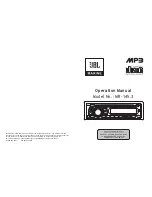
LD2103 V3.0 Page 4 of 33
SRT Marine
Instruction Manual
SRT-MTB
©
Class B Marine AIS
General Warnings
All marine Automatic Identification System (AIS) units utilise a satellite based system such as the Global Positioning Satellite
(GPS) network or the Global Navigation Satellite System (GLONASS) network to determine position.
The accuracy of these networks is variable and is affected by factors such as the antenna positioning, how many satellites are
used to determine a position and how long satellite information has been received for.
It is desirable wherever possible therefore to verify both your vessels AIS derived position data and other vessels AIS derived
position data with visual or radar based observations.
The compass safe distance of this unit is 0.5m or greater for 0.3° deviation.
In accordance with a policy of continual development and product improvement the TRANSAS AIS CLASS B hardware and
software may be upgraded from time to time and future versions of the TRANSAS AIS CLASS B may therefore not correspond
exactly with this manual.
When necessary upgrades to the product will be accompanied by updates or addenda to this manual.
Please take time to read this manual carefully and to understand its contents fully so that you can install and operate your AIS
system correctly.
Information contained in this manual is liable to change without notice.
Transas Ltd. disclaims any liability for consequences arising from omissions or inaccuracies in this manual and any other
documentation provided with this product.
© 2007 Transas Ltd.
FCC Compliance
This equipment has been tested and found to comply with the limits for a Class B digital device, pursuant to part 15 of the
FCC Rules. These limits are designed to provide reasonable protection against harmful interference in a residential installation.
This equipment generates, uses and can radiate radio frequency energy and, if not installed and used in accordance with the
instructions, may cause harmful interference to radio communications. However, there is no guarantee that interference will not
occur in a particular installation. If this equipment does cause harmful interference to radio or television reception, which can be
determined by turning the equipment off and on, the user is encouraged to try to correct the interference by one or more of the
following measures:
•
Reorient or relocate the receiving antenna.
•
Increase the separation between the equipment and receiver.
•
Connect the equipment into an outlet on a circuit different from that to which the receiver is connected.
•
Consult the dealer or an experienced radio/TV technician for help.
The TRANSAS AIS CLASS B- does not contain any user serviceable parts. Repairs should only be made by an authorized
TRANSAS service agent. Unauthorised repairs or modifications could result in permanent damage to the equipment and void
your warranty and you’re authority to operate this equipment under Part 15 regulations.
RF Emissions Notice
Caution: The TRANSAS AIS CLASS B Class B AIS transponder generates and radiates radio frequency
electromagnetic energy. This equipment must be installed and operated according to the instructions contained in this
handbook. Failure to do so can result in personal injury and / or product malfunction.
Caution: Never operate the transponder unless it is connected to a VHF antenna.
To maximise performance and minimise human exposure to radio frequency electromagnetic energy you must make sure that
the antenna is mounted at least 1.5 meters away from the transponder and is connected to the transponder before power is





































